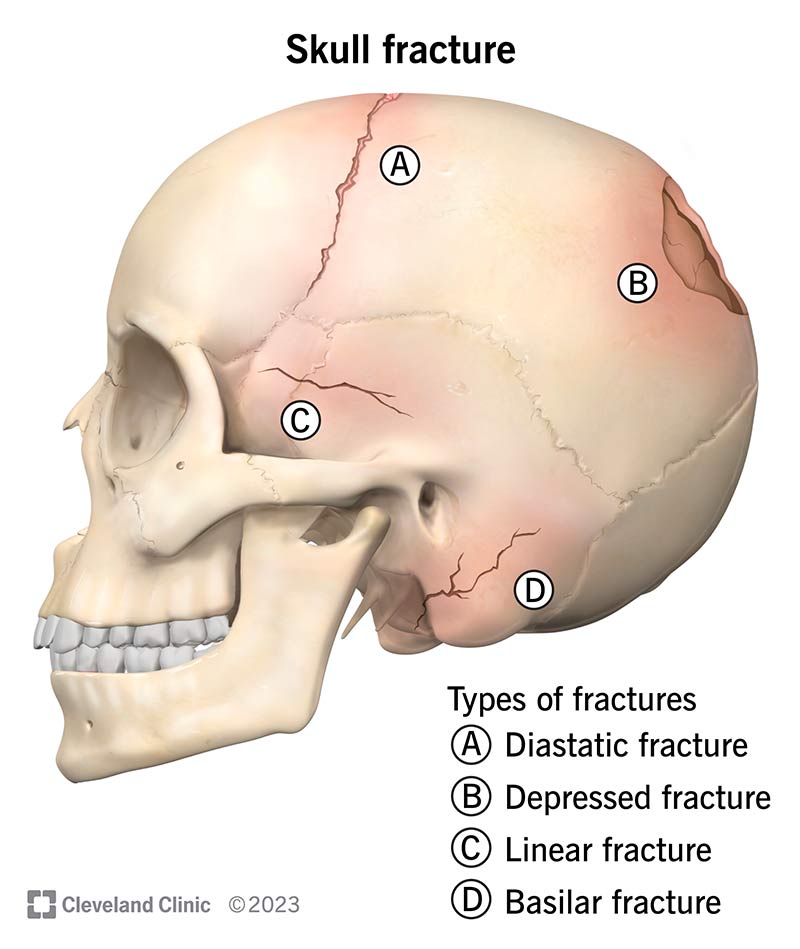A skull fracture is a bone break in your skull. Your skull is the bone structure that surrounds your brain. This head injury is common after vehicle accidents, falls and sports injuries. Some skull fractures are mild and heal on their own. Others may need surgery to repair your skull and prevent complications from affecting your brain.
Advertisement
Cleveland Clinic is a non-profit academic medical center. Advertising on our site helps support our mission. We do not endorse non-Cleveland Clinic products or services. Policy

A skull fracture is a break in the bone structure that surrounds your brain. It’s a type of head injury. Most skull fractures are the result of a blow (impact) to the head.
Advertisement
Cleveland Clinic is a non-profit academic medical center. Advertising on our site helps support our mission. We do not endorse non-Cleveland Clinic products or services. Policy
Most skull fractures are minor and don’t require surgery. However, you should still call 911 or your local emergency services number if you experience a head injury. Some head injuries are life-threatening and require quick treatment for the best outcome.
If the injury affects your brain, you may need surgery to treat it. Some skull fractures heal without treatment, but a healthcare provider will monitor the fracture to make sure there aren’t complications.
There are several types of skull fractures, including:
Advertisement
Another important way to identify the types of skull fractures relates to the skin (scalp) over the fracture:
The exact rate of occurrence of skull fractures is unknown. Each year, more than 2.5 million emergency department visits occur in the United States for traumatic brain injuries (including skull fractures).
Signs of a skull fracture vary based on what type of fracture and where the break occurred, but could include:
One of the first symptoms of a skull fracture is pain from the impact of the injury. Most people with a head injury experience pain.
If the injury affects your brain, you may experience the following:
Skull fractures happen when there’s so much force applied to a bone that it must break. Common ways that a skull fracture can happen include:
Skull fractures are more common among children due to their skulls being thinner and more fragile than those of full-grown adults. Adults over the age of 75 are also at a higher risk of skull fractures because of more frequent falls. You may be more likely to get a skull fracture if you participate in high-risk activities like contact sports.
Complications of skull fractures may include:
Skull fracture complications can be life-threatening.
A healthcare provider will diagnose a skull fracture, usually in an emergency department, following a physical exam and an imaging test like a CT (computed tomography) scan. A CT scan will help your provider see the bones in your skull. A neurological exam will help your provider learn more about how the injury affects your brain. Occasionally, an MRI may also be helpful.
Advertisement
Most skull fractures don’t require any significant medical treatment except treatment related to any head injuries. However, your healthcare provider may recommend you stay in a hospital for a short period following a fracture for observation.
There isn’t a specific treatment for a linear fracture, and it should heal on its own. While in the hospital, your care team will observe you for complications like seizures. If you do have seizures, a healthcare provider will treat those with antiseizure medication.
Short-term use of pain medication may help you feel better after an injury. Sometimes, treatment with acetaminophen is enough to ease your symptoms. Ask your healthcare provider about what type of over-the-counter pain reliever is best for you. If you experience swelling, ice also helps a lot.
Treatment for basal, depressed and diastatic fractures varies based on the severity of your injury but may include:
Advertisement
The healing time for a skull fracture varies based on the type and severity of your injury. It could take several weeks to months for your bones to heal completely.
A skull fracture needs close monitoring to prevent complications. Your healthcare provider will give you specific instructions to take care of yourself. This could include resting in an upright position, changing wound dressings and avoiding blowing your nose if you injure your sinus.
Avoid strenuous activities while your skull heals. Following your healthcare provider’s instructions helps you heal faster and feel better sooner.
Reconstructive surgery may help you feel more confident after an injury if you experience a depressed fracture or an injury that affects your appearance.
Complications are rare but possible after a skull fracture, especially if the fracture injured your brain.
Your outlook after a skull fracture varies based on the severity of your injury, your age and your general health. Most people make a full recovery after a skull fracture. It’s rare to experience long-term complications.
Among children, approximately 80% to 90% of reported head injuries are mild. Skull fractures that are life-threatening or require surgery are less common.
Advertisement
Your healthcare provider can give you the most accurate information about your outlook.
You can’t prevent all skull fractures, but you can take steps to protect yourself from injury by wearing:
Contact 911 or emergency services if you experience a head injury. Get help right away if you:
The bones in your skull are very important to protect your brain. If you experience a head injury, there’s a risk that it could affect or damage your brain. Contact emergency services right away if you experience a head injury. A healthcare provider will provide treatment or monitor your injury and watch for complications. You can reduce your risk of skull fractures by wearing protective equipment, like a helmet when riding a bicycle or motorcycle and wearing a seatbelt when in a vehicle.
If you have a neurological condition, you want expert advice. At Cleveland Clinic, we’ll work to create a treatment plan that’s right for you.

Last reviewed on 11/03/2023.
Learn more about the Health Library and our editorial process.